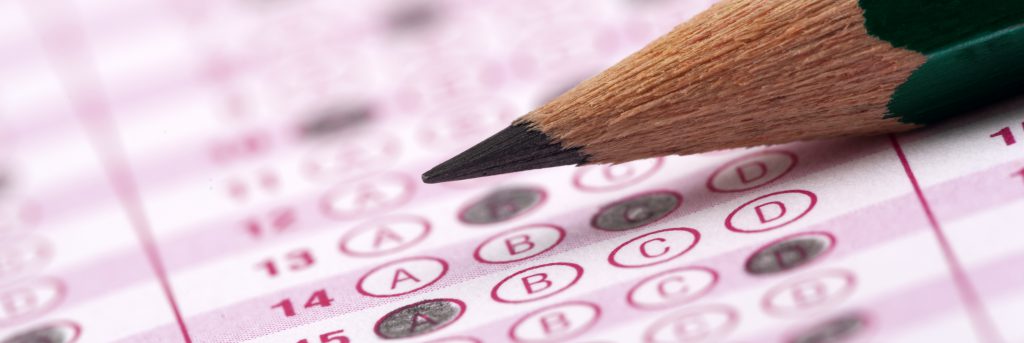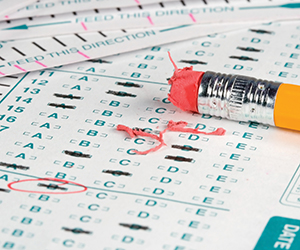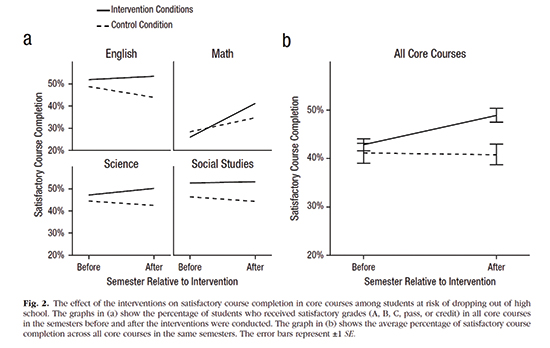Mind Over Midterms

Students at Minneapolis South Senior High have forgotten that their state still requires them to take standardized tests. Almost 90% of the 11th-grade students recently opted out of their district’s math test.
Educators at South High, along with many of their peers across the United States, are urging parents and students to join the “opt-out” movement to counter the rise of standardized testing created by both local school districts and the Common Core State Standards Initiative. Teachers are increasingly concerned that the classroom emphasis is moving toward passing arbitrary benchmarks rather than focusing on learning. Recent reports have found that students’ test anxiety is growing nationwide, as students in some public school districts are taking up to two standardized tests per month.
Despite the “opt-out” rebellion, standardized tests undoubtedly will continue to be a staple of public education for many years to come. Fortunately, psychological scientists are developing tools to help students better navigate the test-ridden environment. Researchers have attempted new intervention methods designed to help students overcome anxieties, stereotypes, negative feedback, and boredom — and the results are promising.
Fixed or Malleable?
As students take test after test, they are inadvertently and repeatedly faced with a question: Am I smart enough to get good grades? Research led by APS James McKeen Cattell Fellow Carol S. Dweck has examined students’ attitudes about their own intelligence and found that there tend to be two camps: entity theorists (those who hold a “fixed mind-set”) and incremental theorists (those who hold a “growth mind-set”).
Entity theorists believe that intelligence is fixed, incapable of expanding and improving; incremental theorists believe that intelligence is malleable and open to change. In a study that tracked hundreds of students across 2 years, beginning as they transitioned into 7th grade, Lisa S. Blackwell of Columbia University, Kali H. Trzesniewski of the University of California, Davis, and Dweck, of Stanford University, showed how these two mind-sets relate to academic beliefs, motivation, and performance:
- Learning versus performance goals: Incremental theorists were more likely to want to learn new things and enjoy challenging schoolwork despite making mistakes. Entity theorists were more likely to pursue work that they were comfortable with and knew they could perform well, validating their existing strengths rather than developing new skills.
- Effort beliefs: Incremental theorists were more likely to believe that working hard is a necessary and effective means of improving ability, whereas entity theorists were more likely to believe that if they had to work hard on a subject, they must not be gifted in that area.
- Response to failure: Entity theorists were more likely to make helpless attributions — such as “I’m not smart enough” or “The test was unfair” — in response to negative feedback. They also were more likely to endorse negative or unproductive strategies, such as cheating, spending less time on a subject, or avoiding it entirely. Incremental theorists, on the other hand, were more likely to put forth additional effort in a class after receiving negative feedback and to spend more time on a challenging subject to increase their aptitude.
 These beliefs and motivational factors in turn predicted performance over time, such that incremental theorists earned better grades than entity theorists.
These beliefs and motivational factors in turn predicted performance over time, such that incremental theorists earned better grades than entity theorists.
“School transitions are very difficult times for students, times when they can easily feel that they lack the intelligence to do well. Giving them a new perspective on intelligence — as something they can develop — may be just what they need to keep them engaged and striving,” said Dweck.
Along similar lines, APS Fellow Joshua M. Aronson of New York University, Carrie B. Fried of Winona State University, and Catherine Good of Baruch College, City University of New York, reasoned that the “fixed” theory of intelligence (i.e., entity theory) may endow the social phenomenon of stereotype threat with part of its negative power. Stereotype threat occurs when people are exposed to a negative stereotype about the abilities of a group they belong to — for example, the notion that African Americans or women are intellectually inferior — and become concerned that they will confirm that stereotype. Because these stereotypes imply an “inalterable deficiency” or a fixed limit, the researchers posit that students affected by stereotype threat actually may be affected by a form of the implicit belief that their intelligence is fixed.
Studies have shown that individuals only need to be aware of the stereotype for it to impose a cognitive and emotional burden — simply asking students to state their race or their gender before taking an exam is enough to elicit the stereotype and impact performance. Students feel anxiety about confirming the negative belief, and this anxiety leads to a stress response that hampers their performance. The negative feedback these students receive when they do poorly often leads them to disengage or devalue the given material, just as entity theorists do.
Rather than attempting to tackle such prevalent and deeply held stereotypes head-on, a Herculean task by any measure, Aronson and colleagues decided to see if they could use incremental theory as a tool to help students combat the threat of negative stereotypes and thereby improve their performance.
Molding Attitudes
To induce the implicit theory of intelligence in college students, Aronson, Fried, and Good designed a “pen pal” intervention in which the college students believed they would be writing to middle schoolers who supposedly were struggling with their classes. Participants in the incremental condition were told to impress upon the children the idea that intelligence is “like a muscle” that can be expanded through practice, and that their pen pals should work hard despite their difficulties. These participants also watched a video highlighting the brain’s ability to grow and make new connections throughout the lifespan, which provided a scientific basis for the message. The students in the control condition watched a video clip of psychologists explaining that intelligence has many different facets and explained to their pen pals that everyone has their strengths and weaknesses, and that the middle schoolers should develop areas where they are strongest. (There was also a non-pen-pal condition.)
The researchers started the intervention in the winter and found not only that Black students endorsed the malleable view of intelligence, but that their belief in it grew stronger with time. By the spring quarter, Black students in the incremental condition reported enjoying and better identifying with the academic process. The experimental condition did not reduce Black students’ perceptions of stereotype threat, but it did effectively combat negative aspects of the threat, indicating that the threat may indeed work through the fixed perspective.
Both White and Black students in the incremental condition showed significant improvement in their grade point averages (GPAs), but the White students did not show the same level of benefits: They did not endorse the incremental theory as strongly, nor did they demonstrate enhanced engagement with or enjoyment of the academic process.
This experimental procedure is now included in the What Works Clearinghouse of the Department of Education’s Institute of Education Sciences, which vets replicated research of high methodological quality.
In another intervention program, Good, Aronson, and APS Fellow Michael Inzlicht (University of Toronto, Canada) targeted the academic performance of female, minority, and low-income 7th-grade students. College students served as mentors to middle schoolers who attended a rural school in Texas in which the student population was predominantly non-White and low-income. The college students met the middle schoolers on two occasions and emailed them weekly throughout the school year, encouraging them in their classes. The mentors guided the students based on a particular set of instructions:
- Incremental condition: Emphasize that intelligence is not finite and that the brain can form new neural connections, and point the students to Web pages with more information (including animations of neurons and dendrites).
- Attributional condition: Tell the students that many junior-high students erroneously think they are not capable of getting good grades when they experience difficulties, but that the novelty of the setting actually can account for their poor performance. Direct them to Web pages that use data to explain how 7th-grade students often exhibit poor grades but improve their performance by 8th grade.
- Combined condition: Use content from both the incremental and attributional conditions to advise students.
- Control condition: Underscore the dangers of drug use. (Each mentor was blind to the research hypotheses and worked with approximately six students.)
After a final standardized achievement test on math and reading at the end of the year, the researchers observed a gender gap in math performance in the control condition that was not present for the participants in the three experimental conditions, in which the girls performed just as well as the boys. Overall, both girls and boys in the three experimental conditions improved their math and reading scores.
But the incremental theory isn’t the only way to improve student performance: Interventions that focus on extending academic goals beyond the classroom and considering one’s place in the greater community have demonstrated boosts in performance as well. Working with minority students in an urban school setting, developmental psychologist David S. Yeager (The University of Texas at Austin) and colleagues asked students to reflect and write about how the world could be a better place and how working hard in school could help them “accomplish meaningful goals beyond [themselves]” and help them contribute to the community. The crux of the intervention’s applicability and success, however, came from the fact that this sense-of-purpose intervention led the students to view tedious academic activities as more meaningful on a personal level. This change in perspective helped the students more successfully self-regulate in spite of boredom and better engage with the material, which led to improved grades.
The New Stuff
Although these interventions and many others have been successful at improving performance, they hadn’t been tested in scalable ways, using methods that could be applied broadly to thousands of students with less control of the environment — until recently.
David Paunesku and Gregory M. Walton of Stanford University, along with a team of psychological researchers that included Dweck and Yeager, conducted a large experimental study, funded by multiple grant foundations, in which academic mind-set interventions were administered over the Internet to more than 1,500 students in 13 US high schools (eight public schools, four charter schools, and one private school) across the country.
Their “growth-mind-set” and “sense-of-purpose” intervention models drew directly from the previously mentioned research and other studies, using reading and writing tasks as a way of inducing students to adopt the specific perspectives. The participants experienced one intervention, both interventions, or neither intervention (control-condition students completed similar-seeming materials).
The researchers found that the interventions significantly improved achievement for the bottom third of the students in the sample, raising their GPA by an average of 0.13–0.18 points, and this effect was not moderated by race or gender. The interventions also led the 367 underperforming students to earn satisfactory grades in core classes at a proportion 8% higher than the control group, resulting in 87 more satisfactory course completions than would be expected based on control rates.
Most importantly, this effect was produced in a large, heterogeneous sample including students and schools from disparate geographical areas and demographic backgrounds, using a reproducible method that could be scaled to a “virtually unlimited number of students at low marginal cost.”
“Among the 4.93 million students who constitute the lowest performing third of high school students nationwide, could this translate into a proportional 1.18 million additional successfully completed courses? The results suggest this possibility,” the researchers write (see figure).

© APS: Paunesku et al., 2015
Although these results offer promising applications, Paunesku and colleagues underscore several caveats. For example, these interventions are effective when students have the opportunities and resources to engage in the classroom, but they could be fruitless for students who do not have the same levels of support. It’s also possible that the interventions are redundant with messages already present in school environments.
The researchers suggest that the growth-mind-set and sense-of-purpose conditions could be integrated into one intervention for a more cohesive experience. Although the intervention did not have a significant effect for students who were not underperforming, longitudinal designs could be used to see whether the programs could be effective in the future as all students eventually encounter more academically rigorous courses.
In addition, Yeager, Paunesku, Walton, Dweck, and a much larger team of psychological scientists conducted a rigorous replication study of this intervention and its findings with a sample roughly two and a half times the size of the original, preregistered hypotheses, tests of generalizability, and a much more engaging control condition — and the results have held up. With an improved design, the researchers found that the intervention still benefited low-achieving students by 0.13 GPA points on average and also improved immediate results on motivations, beliefs, and behaviors. Notably, the high-achieving students who didn’t exhibit significant changes in GPA did display increased challenge-seeking behavior. A new article by many of the same researchers and to be published by Proceedings of the National Academy of Sciences, USA, also has found that the mind-set program implemented for incoming freshmen at The University of Texas at Austin improved GPAs, increased full-time enrollment rates, and reduced achievement gaps for the entire class.
Future Directions
Even though the mentioned studies are all localized to the United States, the theories are not limited to this geographic area. Researchers have found partial support for Dweck’s incremental theory of intelligence among adults returning to school in France, adolescents considering their academic aspirations in England, and college students in Canada.
Researchers also have tested new ideas about the origins of children’s mind-sets. A new study by Kyla Haimovitz (Stanford University) and Dweck finds that parents’ beliefs about failure can impact their child’s mind-sets (see sidebar). And a new study that examined the effects of teaching students about the intellectual and life struggles of famous scientists (Albert Einstein, Michael Faraday, and Marie Curie) has found that the lessons improved students’ interest and learning in science. Although the study may not seem integrally related to the incremental theory, the intervention taught students that intelligence was not perfect or fixed for even the greatest of minds, and the findings demonstrate that the theory’s application can be quite versatile.
Further research on the growth-mind-set and sense-of-purpose interventions is certainly needed, but accumulating findings seem to indicate that psychological science is close to having a widespread tool to help underperforming students improve their performance on standardized tests and in the classroom. Another replication study of the intervention with a nationally representative sample of schools also is being conducted.
As the researchers note, these mind-set interventions are not magic, but they target important psychological processes that are universally involved in the learning process — further research investigating these phenomena will help us understand the many factors that contribute to student achievement.
References
Aronson, J., Fried, C. B., & Good, C. (2002). Reducing the effects of stereotype threat on African American college students by shaping theories of intelligence. Journal of Experimental Social Psychology, 38, 113–125.
Blackwell, L. S., Trzesniewski, K. H., & Dweck, C. S. (2007). Implicit theories of intelligence predict achievement across an adolescent transition: A longitudinal study and an intervention. Child Development, 78, 246–263.
Good, C., Aronson, J., & Inzlicht, M. (2003). Improving adolescents’ standardized test performance: An intervention to reduce the effects of stereotype threat. Applied Developmental Psychology, 24, 645–662.
Lazarín, M. (2014, October 16). Testing overload in America’s schools. American Progress. Retrieved from http://files.eric. ed.gov/fulltext/ED561097.pdf
Matos, A. (2016, April 11). Hundreds of Minneapolis South High students opt out of state tests. Star Tribune. Retrieved from http:// www.startribune.com/hundreds-of-students-at-minneapolissouth-high-opt-not-to-take-standardized-exams/375203861/
Paunesku, D., Walton, G. M., Romero, C., Smith, E. N., Yeager, D. S., & Dweck, C. S. (2015). Mind-set interventions are a scalable treatment for academic underachievement. Psychological Science, 26, 784–793. doi:10.1177/0956797615571017
Yeager, D. S., Henderson, M. D., D’Mello, S., Paunesku, D., Walton, G. M., Spitzer, B. J., & Duckworth, A. L. (2014). Boring but important: A self-transcendent purpose for learning fosters academic self-regulation. Journal of Personality and Social Psychology, 107, 559–580. doi:10.1037/a0037637
Yeager, D. S., Romero, C. R., Paunesku, D., Hulleman, C. S., Schneider, B., Hinojosa, C., … Dweck, C. S. (2016). Using design thinking to improve psychological interventions: The case of the growth mindset during the transition to high school. Journal of Educational Psychology, 108, 374–391.
Yeager, D. S., Walton, G. M., Brady, S. T., Akcinar, E. N., Paunesku, D., Keane, L., … Dweck, C. S. (in press). Is it possible to improve the college transition in advance? Teaching a lay theory before college narrows achievement gaps at scale. Proceedings of the National Academy of Sciences, USA.




APS regularly opens certain online articles for discussion on our website. Effective February 2021, you must be a logged-in APS member to post comments. By posting a comment, you agree to our Community Guidelines and the display of your profile information, including your name and affiliation. Any opinions, findings, conclusions, or recommendations present in article comments are those of the writers and do not necessarily reflect the views of APS or the article’s author. For more information, please see our Community Guidelines.
Please login with your APS account to comment.